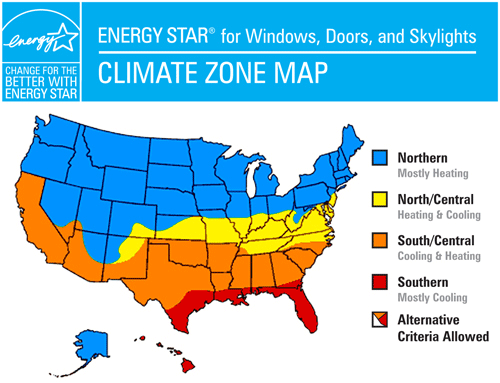One of the primary purposes for purchasing new replacement windows is saving energy. With varying temperatures and climates across the United States, it’s important to understand that energy ratings for replacement windows vary depending on climate. Climate is an important factor to consider when you’re in the market for new windows, and the Glass Pack in your replacement windows helps determine how your window performs in certain climates.
Glass packs are insulated glass packages that exist in Double Pane and Triple Pane windows, and contain energy efficient materials that enhance the performance of your window. Think of a Glass Pack as the engine that drives the performance of a window.
The performance of your window boils down to U-Factor and Solar Heat Gain Coefficient (SHGC) levels in the window. The U-Factor measures the rate of heat transfer through a window, and the SHGC level determines how well the glass blocks solar heat. Furthermore, the energy efficiency of a window is better determined by the U-Factor in cooler climates and the SHGC in warmer climates.

Replacement Windows for Temperate Climates: In climates that are cold in the winter and warm in the summer, concentrate on the U-Factor more than the SHGC level, although your best bet is to combine a low U-Factor with a high SHG level in these area-specific climates. You don’t want to block out a large amount of solar heat, since this natural heat helps warm your home when it’s needed. Look for windows with a U-Factor level of .30 or lower to achieve the best results in energy efficiency.
Replacement Windows for Cool and Rainy Climates: Look for windows with a U-Factor of .30 or lower and a SHGC of .30 or higher in order to achieve solar heating in the winter months; this helps lower your heating bill. Applying a coat of Low-E on the inside of windows in cold climates will keep heat inside during the winter months and keep the heat outside during the summer months. Additionally, those living in rainy climates may find that wood frames are not the best choice for new windows; opt for vinyl replacement windows if you live in a particularly moist climate.
Replacement Windows for Hot and Dry Climates: In hot climates, a coat of Low-E applied to your window is essential. Without it, you will have a bad SHGC rating, which will result in solar heat shooting right through the window and heating up your house. Some companies will tell you that vinyl replacement windows are bad choices for hot climates; however, vinyl replacement windows can withstand temperatures of up to 158° Fahrenheit.
Replacement Windows for Coastal & Hurricane Prone Climates: The best replacement windows for coastal climates and areas prone to hurricanes are Impact Windows. Impact Windows are manufactured to withstand harsh hurricane conditions and are virtually indestructible. Impact Windows are available through the Clear Choice USA & Window Depot USA network.
Keep in mind that Triple Pane Replacement Windows are effective for any climate. Triple Pane Windows maximize energy efficiency with a third pane of glass that is proven to lower utility bills, reduce noise, increase insulation and reduce interior condensation on your windows.